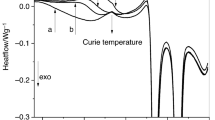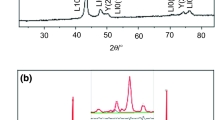Abstract
Additions of antimony, selenium, tellurium and some other alloying elements to iron-nickel base alloys have been investigated with regard to effects on melt surface tension and resultant metallic glass formation and characteristics. Surface tension of the molten alloys has been measured as a function of composition and melt temperature using a variation of the maximum bubble pressure method. The density of molten Fe40Ni40B20 alloy has been measured as a function of temperature. Attempts to chill block melt-spin and alloys of the present investigation into metallic glass ribbons were largely successful. A few compositions were partially crystalline in the as-cast state and even fewer were not castable at all. The amorphous structure of ribbons made was assessed by X-ray diffraction, differential scanning calorimetry, and embrittlement temperatures for one hour anneals. A correlation has been established between changes in melt surface tension and metallic glass embrittlement temperature with the addition of surface active elements.
Similar content being viewed by others
References
P. Kozakevitch, “Surface Phenomena of Metals”, SCI; Monograph No. 28 (Society of Chemical Industry, London, 1968) p. 223.
H. H. Liebermann, General Electric Corporate R&D, Schenectady, NY, 1981 (unpublished research).
V. G. Levich, “Physicochemical Hydrodynamics” (Prentice-Hall, Inc., Englewood Cliffs, NJ, 1962) p. 391.
H. H. Liebermann andF. E. Luborsky,Acta Metall. 29 (1981) 1413.
V. K. Semenchenko, “Surface Phenomena in Metals and Alloys” (Pergamon Press, 1961) p. 43.
Z. Morita andA. Kasama,Trans. Jpn. Inst. Met. 21 (1980) 522.
L. Lucas, in “Physicochemical Measurements in Materials Research”, Vol. 4, Part 2 (1970) p. 273.
B. C. Allen, in “Liquid Metals Chemistry and Physics”, edited by S. Z. Beer (Marcel Dekker, New York, 1972) Chap. 4.
H. H. Liebermann,Mater. Sci. Eng. 43 (1980) 203.
I. Lauermann, G. Metzger andF. Sauerwald,Wiss. Z. Univer. Halle XIII, No. 10 (1964) p. 773.
M. L. McGlashan,J. Chem. Ed. 43 (1966) 226.
M. Shimoji, “Liquid Metals” (Academic Press, London 1977) p. 48.
J. J. Gilman,Phil. Mag B 37 (1978) 577.
V. B. Lazarev andO. A. Timofeevicheva, in “Surface Phenomena in Metallurgical Processes”, edited by A. I. Belyaev (Consultants Bureau, New York, 1965) p. 64.
Author information
Authors and Affiliations
Rights and permissions
About this article
Cite this article
Liebermann, H.H. Effects of elemental additions and superheat on melt surface tension and metallic glass embrittlement. J Mater Sci 19, 1391–1396 (1984). https://doi.org/10.1007/BF00563033
Received:
Accepted:
Issue Date:
DOI: https://doi.org/10.1007/BF00563033




